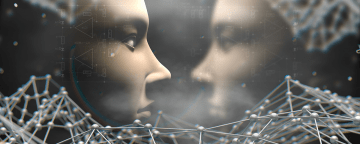Bob Grant in The Scientist:
 You’d think that overseeing an entire issue of The Scientist focused on artificial intelligence would cause my mind to wander far into the future—robotic researchers formulating digital hypotheses, whizzing about in sleek, metallic labs. But immersing myself in stories about the novel insights and deep analyses enabled by smart instruments and machine learning did not transport me into a vision of science in the 23rd century.
You’d think that overseeing an entire issue of The Scientist focused on artificial intelligence would cause my mind to wander far into the future—robotic researchers formulating digital hypotheses, whizzing about in sleek, metallic labs. But immersing myself in stories about the novel insights and deep analyses enabled by smart instruments and machine learning did not transport me into a vision of science in the 23rd century.
Instead, I found myself thinking of the distant past, of a time when the first micro-vibrations of life were roiling the raw muck of early Earth. Rather than the grand sweep of what artificial intelligence may bring about—faster and more economical data processing, new insights, novel discoveries, and revolutionized workflows and transportation systems—I thought of the original form of intelligence on our planet. Intelligence on the molecular scale.
The Miller-Urey experiment of the 1950s began to shed mechanistic light on the dark mysteries of how Earth changed from an inanimate sphere to a planet bursting with life. But those famed researchers could zap into existence only amino acids, the building blocks of proteins. Later experiments pushed the chemical evolution toward life further by generating nitrogenous bases, the building blocks of RNA and DNA. But researchers have not yet succeeded in demonstrating a route from raw chemical materials to those crucial macromolecules. And it was through RNA, DNA, or both that life really burst from the starting blocks, those plucky nucleic acids acquiring a sort of self-motivation to replicate. That, I believe, was the dawn of intelligence.
More here.
